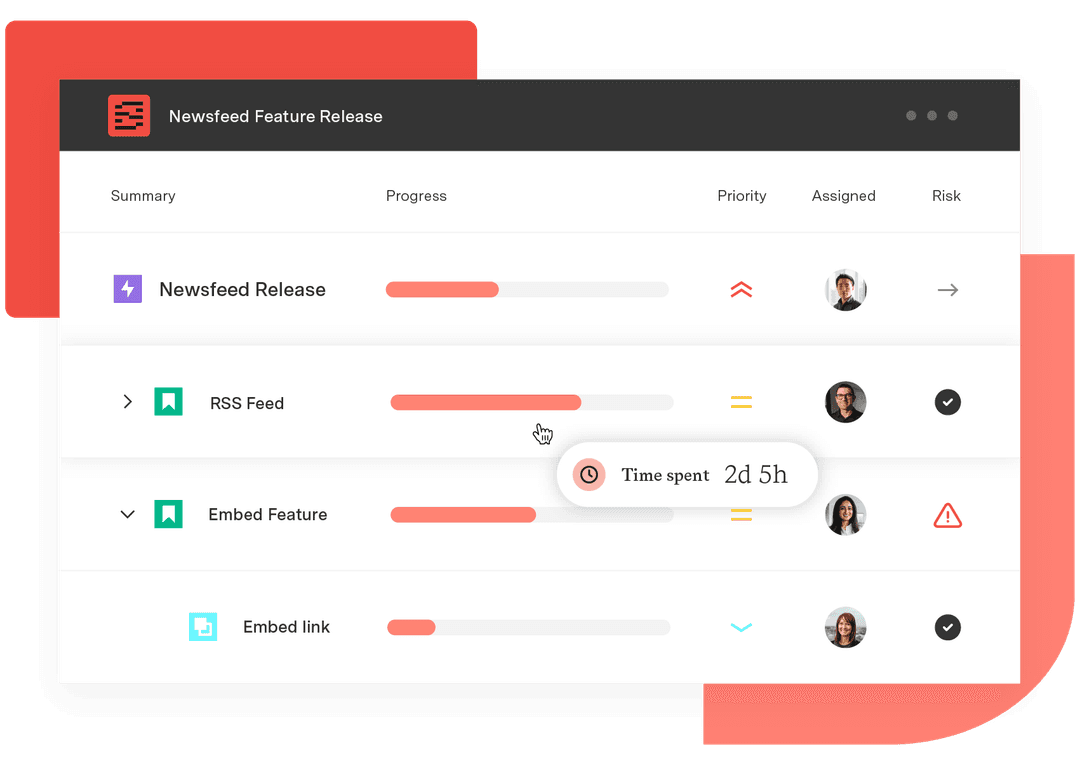8 OKR templates to set and track team goals
Tempo Team
Setting objectives is critical for the early stages of project planning, but effectively monitoring those objectives is what drives results. Whether you're organizing at the company level or setting personal development goals, an objective and key results (OKR) template ensures consistency and clarity in your goals.
In this guide, we’ll break down the core components of a strong OKR format, share eight use-case-driven templates, and show how Tempo’s Jira-native tools make it easier to track goals, from planning to execution.
What’s an OKR template?
An OKR template is a structured document or digital format that helps teams define and monitor goals using trackable metrics. Whether you're using an OKR template in Excel, building a dashboard in Google Sheets, or integrating with Jira, the goal is the same: to give everyone a shared view of what success looks like.
By using a repeatable OKR planning template, organizations reduce miscommunication and support clarity and accountability in their practices.
What’s the format of OKRs?
OKRs follow a simple but powerful structure.
Objective: A clear goal that defines what you want to achieve. Objectives should be qualitative and outcome-focused.
Example: Improve the user onboarding experience.
Key results: A quantitative benchmark that indicates how you’ll measure progress toward the qualitative objective. Most objectives have three to five key results. They should be specific, measurable, and time-bound.
Example:
Reduce time to complete onboarding flow by 30%
Increase first-month retention from 85% to 95%
Collect onboarding feedback from at least 150 users
Best practices: Keep objectives inspirational but grounded in reality, and make sure you align your OKRs to team and company priorities. Define a clear timeframe (e.g., quarterly), and check back on progress as you go.
Following this OKR framework template helps teams avoid vague goals and track progress objectively.
8 OKR templates
No matter your role or planning cycle, there’s an OKR format to match. Below are eight OKR templates designed for different use cases, from strategic planning to personal development.
1. Company-wide OKR template
This template helps leadership set strategic objectives that guide the entire organization. It ensures all departments are moving toward shared, measurable goals and supports high-level performance tracking across teams.
Example:
Objective: Expand international market presence in 2025.
Key result 1: Launch operations in three new countries by Q3.
Key result 2: Increase international revenue by 40% year-over-year.
Key result 3: Hire 10 new regional sales managers across target markets.
A company-wide OKR template is best for executive teams and quarterly leadership reviews. It supports executive reporting by linking measurable results to strategic company goals.
2. Department OKR template
Designed for functional teams like marketing, sales, or engineering, this template translates top-level goals into team-level priorities.
Example:
Objective: Improve inbound marketing performance.
Key result 1: Grow blog traffic by 50% by end of quarter.
Key result 2: Generate 500 new MQLs through gated content.
Key result 3: Improve landing page conversion rate by 4%.
This type of OKR helps departments align with company-wide OKRs while focusing on smaller, team-oriented outcomes.
3. Tracking OKR template
A tracking OKR template is useful for ongoing management. It includes sections for ownership, current status, progress percentage, and blockers. It’s great for smaller sprint cycles, like weekly reviews or team standups.
Example:
Objective: Enhance customer satisfaction metrics.
Key result 1: Increase NPS score to 70.
Key result 2: Reduce average resolution time to under two hours.
Key result 3: Implement post-ticket surveys with a 75% response rate.
Teams can visualize tracking OKR progress using Custom Charts for Jira, enhancing visibility across leadership levels.
4. Initiative OKR template
Best for short-term campaigns or project roadmaps, this template helps clarify the objective of a specific initiative and aligns contributors around tangible outcomes.
Example:
Objective: Launch a new self-service support portal.
Key result 1: Publish 50 support articles before go-live.
Key result 2: Reduce support tickets by 25 % in the first quarter post-launch.
Key result 3: Achieve an 80% portal adoption rate among users.
5. Individual OKR template
This template connects an employee's goals to broader team or company objectives, making it useful for personal development and performance reviews.
Example:
Objective: Strengthen team communication and collaboration.
Key result 1: Facilitate three cross-team workshops this quarter. Key result 2: Lead biweekly project syncs with design and engineering.
Key result 3: Complete conflict resolution training by quarter-end.
6. Quarterly planning OKR template
Use this template to define and track goals within a quarterly cycle. It helps prioritize short-term focus areas that ladder up to yearly and longer-term goals.
Example:
Objective: Optimize product onboarding experience
Key result 1: Reduce time-to-value for new users to five minutes.
Key result 2: Increase onboarding email click-through rate to 20%.
Key result 3: Launch interactive onboarding tour by the end of the quarter.
This OKR format complements agile release planning by ensuring short-term priorities are as clear as possible.
7. Startup OKR template
This template is tailored for early-stage teams and emphasizes agility, product-market fit, and resource-focused outcomes without overcomplicating the process.
Example:
Objective: Establish product-market fit.
Key result 1: Conduct 30 user interviews with the target audience.
Key result 2: Reach 1,000 weekly active users by end of Q2.
Key result 3: Achieve a 20%retention rate after 30 days.
8. Rollout OKR template
If your company is adopting the OKR framework for the first time, this template guides a smooth rollout across measurable milestones.
Example:
Objective: Successfully implement OKRs across the organization.
Key result 1: Host four OKR training sessions for managers.
Key result 2: Achieve 100% OKR submissions from all departments.
Key result 3: Launch an internal OKR dashboard for visibility.
With these templates, you’ll be able to build a strategic plan around a clear vision and work toward your short and long-term company goals.
Align team and company OKRs with Tempo
OKRs are most powerful when tied to real work and measurable results. Tempo helps teams bridge the gap between strategy and execution by embedding OKR tracking directly into Jira.
With Structure PPM, teams can build OKR hierarchies that connect objectives to ongoing projects and tasks. This makes it easier to see how team goals align with company outcomes and to adjust when priorities shift.
Strategic Roadmaps provides a visual overview of timelines, goals, and dependencies. Teams can track progress on OKRs and communicate updates clearly, whether reviewing with leadership or planning the next sprint.
By bringing OKRs into the tools teams already use, Tempo ensures that goal-setting becomes a core part of daily execution, not just an annual exercise.










































